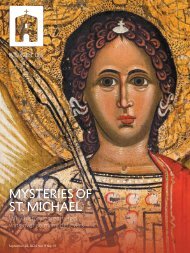Angelus News | August 2-9, 2019 | Vol. 4 No. 27
A nationwide trend pushing to remove tributes to certain historical figures of U.S. history has seized on a new, unlikely target: the bells lining California’s iconic El Camino Real. The reason? The belief that Spanish missionaries — among them St. Junípero Serra — were oppressors, captors, and even murderers of California’s first peoples. On Page 10, renowned historian Gregory Orfalea examines the most common critiques of the Spanish evangelization of California and makes the case for why the bells represent a legacy of love, not oppression.
A nationwide trend pushing to remove tributes to certain historical figures of U.S. history has seized on a new, unlikely target: the bells lining California’s iconic El Camino Real. The reason? The belief that Spanish missionaries — among them St. Junípero Serra — were oppressors, captors, and even murderers of California’s first peoples. On Page 10, renowned historian Gregory Orfalea examines the most common critiques of the Spanish evangelization of California and makes the case for why the bells represent a legacy of love, not oppression.
You also want an ePaper? Increase the reach of your titles
YUMPU automatically turns print PDFs into web optimized ePapers that Google loves.
The monochrome sanctuary and Hazel White organ during the dedication Mass July 17.<br />
COURTESY DIOCESE OF ORANGE<br />
the interior has the look and feel of an<br />
airline terminal, it took me a minute<br />
to realize we were in the actual<br />
cathedral.<br />
All pale marble and limestone, the<br />
monochrome sanctuary’s dominant<br />
feature consists of 11,000 silver-white<br />
quatrefoils — triangular metal “sails,”<br />
that cost $6 million and completely<br />
line the geometrically precise walls<br />
and ceiling. Even the renowned Hazel<br />
White organ, with its 16,000 pipes,<br />
has been painted white.<br />
Donning a cherry-red ball gown,<br />
“America’s Got Talent” star Jackie<br />
Evancho kicked off the concert, the<br />
first ever in this sacred space, with<br />
“Some Enchanted Evening.”<br />
Needless to say, it took a while to get<br />
my bearings. Finally I realized, oh<br />
THERE are the vaunted baldacchino,<br />
the bishop’s chair, and the “crux gemmata”<br />
(“jewelled cross”) inlaid with<br />
precious jewels.<br />
Originally designed by Philip Johnson<br />
of the “Chippendale Dresser”<br />
AT&T Building fame, the cathedral<br />
received its makeover from Scott<br />
Johnson of the LA firm Johnson Fain.<br />
There are some lovely touches: the<br />
20-foot bronze entry doors; the bas-relief<br />
Stations of the Cross, also bronze,<br />
by Bolivian artist Pablo Eduardo (with<br />
more work by him to come). The 34-<br />
acre campus houses six other buildings,<br />
including one each by Richard<br />
Neutra and Richard Meier.<br />
The cathedral alone, along with the<br />
adjacent 236-foot mirrored spire, really<br />
deserves a separate trip and several<br />
hours.<br />
And to be fair, as airline terminals<br />
go, this one is transcendent. Since the<br />
cost of tearing down the building and<br />
new construction would have been<br />
prohibitive, the diocese had to work<br />
with what it had. Our own Auxiliary<br />
Bishop Robert Barron imagines the<br />
new cathedral as “a vibrant center of<br />
evangelization.”<br />
But the attempt to turn a Protestant<br />
televangelist megachurch designed<br />
by a maverick postmodernist into a<br />
Catholic cathedral was bound to generate<br />
a certain amount of blowback.<br />
Los Angeles Times architecture critic<br />
Christopher Hawthorne, for example,<br />
describes the renovation as having<br />
“far more in common with the nearby<br />
Mattherhorn at Disneyland, the<br />
Biosphere in Arizona or the domes<br />
of Buckminster Fuller than with any<br />
cathedral in Europe.”<br />
I guess it all depends on perspective.<br />
In my mind, a church should be<br />
hushed, with a gloomy corner or two,<br />
and the merciful twilight of a convalescent<br />
home. A church needs imagery,<br />
however high or low, that speaks<br />
of consecrated time and space; of a<br />
world beyond this one; of sin, redemption,<br />
eternity, and sacrificial love.<br />
With all that, the Catholic novelist<br />
Flannery O’Connor observed that the<br />
Mass involves the same act if it’s said<br />
out of a suitcase in a boiler room or at<br />
St. Peter’s in Rome. That’s what will<br />
bring the cathedral alive: Mass, and us<br />
rank-and-file members of the faithful.<br />
As St. Ambrose observed, “The<br />
Church is beautiful in her saints.”<br />
A saint would remember, as I should<br />
more often, that people who live in<br />
glass houses shouldn’t throw stones. A<br />
saint would kneel before the altar, any<br />
altar, and ask, along with Elizabeth,<br />
“Who am I, that the mother of our<br />
Lord should come to me?”<br />
Dinner was splendid. The staff,<br />
our host, and our table companions<br />
couldn’t have been warmer or more<br />
fun. Jamie and I were both honored<br />
to have been invited and thoroughly<br />
enjoyed the evening.<br />
Plus now that I have a fancy dress,<br />
I’m all set for the next bash. <br />
Heather King is a blogger, speaker and the author of several books.<br />
<strong>August</strong> 2-9, <strong>2019</strong> • ANGELUS • 33


















